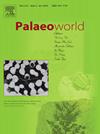Mississippian foraminifera from the Lueyang Formation in Guozhen area, South Qinling Orogen, China
IF 1.7
3区 地球科学
Q2 PALEONTOLOGY
引用次数: 0
Abstract
The Mianlue Suture Belt, located in the southern part of the Qinling Orogenic Belt, is a significant tectonic zone in China that formed by the collision of the South China Block with the North China Block during Triassic. The Lueyang Formation, distributed along the southern margin of the Mianlue Suture Belt, is one of the major components of the Late Paleozoic marine strata of the Mianlue Belt. Unfortunately, only a few published paleontological studies are available. This hinders the understanding of the age and sequence of this formation and the evolution of the Mianlue Ocean. Herein, we report, for the first time, at least 51 species and 25 genera of foraminifera from the Lueyang Formation at the Zhuyuanba section. The Zhuyuanba foraminiferal fauna is dominated by Eostaffella, Archaediscus, Paraarchaediscus, Omphalotis, Bradyina, Janischewskina, Endothyra and Mediocris, and possesses some stratigraphically important taxa such as Bradyina cribrostomata, Janischewskina spp. and Paraarchaediscus stilus. Two foraminiferal zones are recognized in the Lueyang Formation, ascendingly the Visean Paraarchaediscus stilus Zone and Serpukhovian Bradyina cribrostomata Zone. So, the age of the Lueyang Formation at the Zhuyuanba section is considered from Visean to Serpukhovian. This paper confirms for the first time that the Lueyang Formation contains the Visean and Serpukhovian strata, providing new paleontological evidence for understanding the evolution of the Mianlue Ocean during the Late Paleozoic.
南秦岭国镇地区庐阳组密西西比系有孔虫
绵略缝合带位于秦岭造山带南段,是三叠纪华南地块与华北地块碰撞形成的中国重要构造带。露阳组分布在绵留缝合带南缘,是绵留带晚古生代海相地层的主要组成部分之一。不幸的是,只有少数发表的古生物学研究是可用的。这阻碍了对该地层年龄、层序和绵略洋演化的认识。本文首次报道了朱元坝剖面露阳组有孔虫至少51种25属。朱元巴有孔虫区系以Eostaffella、Archaediscus、Paraarchaediscus、Omphalotis、Bradyina、Janischewskina、Endothyra和ris为主,并有Bradyina cribrostomata、Janischewskina spp.和Paraarchaediscus stilus等重要的地层学类群。吕阳组有两个孔虫带,依次为Visean Paraarchaediscus stilus带和Serpukhovian Bradyina cribrostomata带。因此,朱元坝剖面鲁阳组的时代可认为是从维桑世到谢尔普霍夫世。本文首次确认了辽阳组包含Visean和serpukhova两套地层,为认识绵略洋晚古生代的演化提供了新的古生物证据。
本文章由计算机程序翻译,如有差异,请以英文原文为准。
求助全文
约1分钟内获得全文
求助全文
来源期刊

Palaeoworld
PALEONTOLOGY-
CiteScore
4.00
自引率
5.90%
发文量
95
期刊介绍:
Palaeoworld is a peer-reviewed quarterly journal dedicated to the study of past life and its environment. We encourage submission of original manuscripts on all aspects of palaeontology and stratigraphy, comparisons of regional and global data in time and space, and results generated by interdisciplinary investigations in related fields. Some issues will be devoted entirely to a special theme whereas others will be composed of contributed articles. Palaeoworld is dedicated to serving a broad spectrum of geoscientists and palaeobiologists as well as serving as a resource for students in fields as diverse as palaeobiology, evolutionary biology, taxonomy and phylogeny, geobiology, historical geology, and palaeoenvironment.
Palaeoworld publishes original articles in the following areas:
•Phylogeny and taxonomic studies of all fossil groups
•Biostratigraphy, chemostratigraphy, chronostratigraphy
•Palaeoecology, palaeoenvironment and global changes throughout Earth history
•Tempo and mode of biological evolution
•Biological events in Earth history (e.g., extinctions, radiations)
•Ecosystem evolution
•Geobiology and molecular palaeobiology
•Palaeontological and stratigraphic methods
•Interdisciplinary studies focusing on fossils and strata
 求助内容:
求助内容: 应助结果提醒方式:
应助结果提醒方式:


